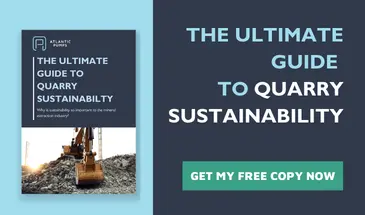Dust Suppression Water Pumps: Essential To Safeguard Employees' Health
Wherever minerals are extracted, dust inhalation poses a substantial risk to personnel wellbeing. Quarries are full of dust-creating activities including blasting, crushing, screening and haulage. To protect their workforces, quarry managers must make dust suppression part of their operational health and safety regime.
Furthermore, it is imperative to most sites’ planning permission that quarries sufficiently address dust migration concerns.
Without any control measures, dust can turn from a nuisance to neighbours, into an environmental and public health problem for those living near dust-generating industries. Thankfully, many well-tested and proven dust control methods are employed by today’s responsible quarry and aggregate plant operators.
Regulations
Dust is covered under the Control of Substances Hazardous to Health Regulations 2002 (COSHH). Construction and demolition dust contains many potentially harmful respirable compounds including silicates, limestone, marble and dolomite fine powder (‘fines’). When absorbed into the lungs, these can cause a multitude of diseases such as chronic obstructive pulmonary disease (COPD), asthma, silicosis or lung cancer.
The Health and Safety Executive’s COSHH regulations state that employers have a legal responsibility to provide protection measures against dust.
The HSE has also provided some useful guidance and resources to help ensure that you are complying with the Control of Pollution Act 1974 and other existing regulations:
Relevant HSE guidance includes:
COSHH G409 Exposure Sampling Measurement Air Sampling
HSG173 Monitoring strategies for toxic substances
Methods for the Determination of Hazardous Substances (MDHS)
Health Issues
Long-term exposure to construction dust may prove fatal to workers. It is reported that workers die every week from lung diseases caused by exposure to dust, whilst others suffer from chronic long-term conditions.
The finer the dust, the harder it is for the body’s defences to filter and expel it. This makes fine dust even from innocuous minerals a potential risk.
A 2023 HSE report on occupational disease revealed that 1.7 million workers currently suffer from work-related ill health, and 12,000 deaths from lung disease per year were linked to exposures at work.
As such, the mitigation, capture and suppression of dust emissions is a vital factor in determining planning applications for quarries, aggregate, and recycling plants and reducing dust-related health risks. Fortunately, there are many methods available to prevent dust from becoming damaging to workers and their environment.
Types
Dust is divided into two types: organic and inorganic, depending on the source and particle size (the latest affects dust mobility in air and its inhalation risks). According to Rebecca Dezube, from John Hopkins University, only particles of “less than 3 to 5 microns” can penetrate the deep lung.
Organic dust comes from plant and animal matter and tends to act as a transmitter for respiratory diseases. Inorganic dust, however, comes from rock and soil particulates and is mostly responsible for cancer and other serious illnesses, when inhaled as “respirable dust”. Moreover, some inorganic dust sources, such as lime or cement, have a high pH value and are corrosive to lung tissue.
Dust over 10 microns in size is often referred to as ‘nuisance dust’ as it is visible and tends to settle easier than finer particles. Below this, we have PM10 (particulate matter less than 10 microns), and PM2.5 commonly quoted in air quality measurements.
Data compiled by industry body Mineral Products Association (MPA) shows that quarrying is responsible for 4.6% of PM10 and 0.8% of PM2.5 of UK industrial emissions (UK National Atmospheric Emissions Inventory 2019)
Equipment
Dust can be damaging to equipment, machinery, plants as well as workers. If it is not properly dealt with, it may accumulate on and inside the equipment. Working its way into tiny nooks and crannies, it can lead to damages, reduced efficiency and diminished lifespan. Inevitably, this means seriously increased operating costs.
Furthermore, when dust damage goes unnoticed, it can lead to equipment failures that create serious hazards for workers.
Water For Dust Suppression
Water misting is a highly effective method, with dust suppression water pumps a common presence on quarry sites. However, relying on public water supplies for dust suppression systems can be costly at scale.
With permission from local authorities, water can either be harvested from rainwater or greywater and even abstracted from rivers. These activities are regulated through abstraction or impounding licences obtained from the EA (England and Wales), or SEPA (Scotland).
Grey water must be cleaned before use to prevent excessive wear and blockages of pump misting equipment. See how Tarmac achieved this in our case study.
For more information, download our white paper about dust suppression for quarry operators.


